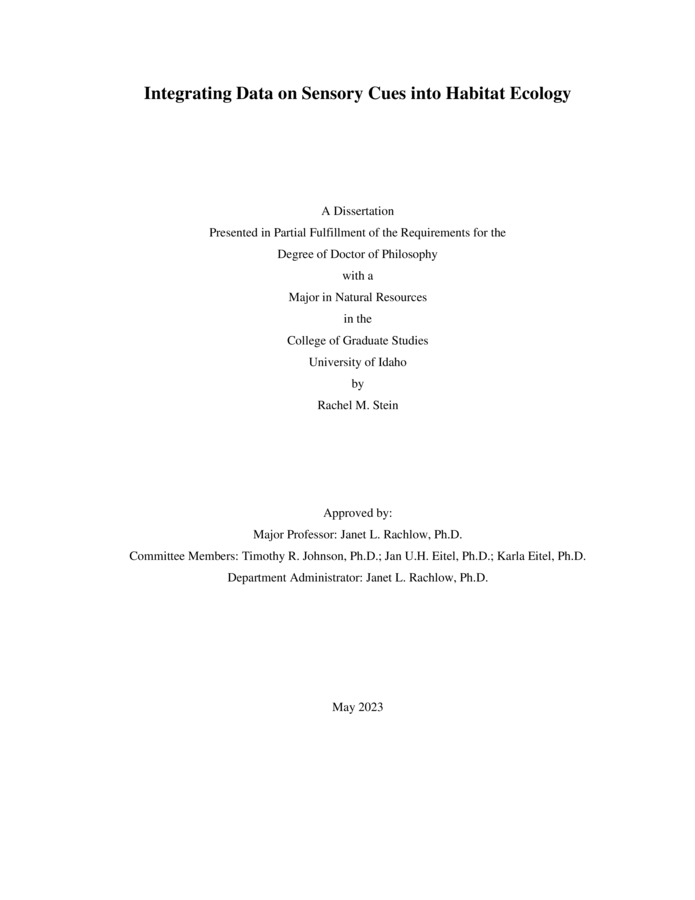Integrating Data on Sensory Cues into Habitat Ecology
Stein, Rachel M. (2023-05). Integrating Data on Sensory Cues into Habitat Ecology. Theses and Dissertations Collection, University of Idaho Library Digital Collections. https://www.lib.uidaho.edu/digital/etd/items/stein_idaho_0089e_12570.html
- Title:
- Integrating Data on Sensory Cues into Habitat Ecology
- Author:
- Stein, Rachel M
- ORCID:
- 0000-0003-1885-1287
- Date:
- 2023-05
- Keywords:
- acoustic ecology concealment lidar sound viewshed visibility
- Program:
- Fish & Wildlife Sciences
- Subject Category:
- Ecology; Wildlife conservation; Wildlife management
- Abstract:
-
Integrating sensory information into habitat ecology is key to understanding the mechanisms that link an individual’s perception to its use of resources. My objective was to further understanding of the mechanistic links between sensory information, habitat, and resource use and also engage students in sensory ecology by: 1) reviewing knowledge about the acoustic ecology of terrestrial mammals; 2) evaluating how diverse environments influence individual access to visual information; 3) testing hypotheses about the influence of visual habitat properties on selection by mammalian prey; and 4) using remote sensing techniques of estimating visual habitat properties to engage undergraduate students in experiential curriculum advancing their knowledge of sensory ecology and habitat selection by wildlife. To review knowledge about acoustic ecology of mammals, I conducted a systematic review of published literature indexed in the Web of Science. To contextualize all the information in the review, I created a Signaler-Receiver conceptual framework, which orders reviewed information into factors that influence signalers (mammals that emit sound) and receivers (mammals that receive sound). I also identified gaps in knowledge including a heavy emphasis on highly vocal groups. My review is the first to explicitly detail the breadth of factors influencing acoustic behaviors in terrestrial mammals. To evaluate visual information accessible to individuals as a function of habitat, I collected terrestrial lidar data in four disparate ecosystems (forest, shrub-steppe, prairie, and desert). Within the resulting point clouds, I conducted viewshed analyses. Ecosystem-specific structure and animal position significantly influenced viewsheds demonstrating that visibility is a spatially dynamic visual property that animals can select for when choosing habitats and may also influence resource use within habitats. To investigate how visual properties of the environment contribute to habitat use, I evaluated habitat selection by pygmy rabbits (Brachylagus idahoensis). At patches used by and available to pygmy rabbits, I estimated visibility (using terrestrial lidar) and concealment (using image classification). I also estimated these properties at microsites where I indexed intensity of use by counting fecal pellet density. Pygmy rabbits selected patches with dense and tall vegetation that was associated with small viewsheds, and did not select for concealment. In contrast, at microsites, pygmy rabbits used microsites near their burrows associated with high concealment. This study illustrates how multiple properties of cover influence selection in nuanced ways. Finally, I designed and implemented an experiential course for undergraduate students at the University of Idaho focused on research assessing visual properties of wildlife habitat. A majority of the course was spent conducting field world. A key feature of the course was introducing students to lidar. Students reported that field work and lidar activities were the most useful for achieving learning goals.
- Description:
- doctoral, Ph.D., Fish & Wildlife Sciences -- University of Idaho - College of Graduate Studies, 2023-05
- Major Professor:
- Rachlow, Janet L
- Committee:
- Johnson, Timothy R; Eitel, Jan UH; Eitel, Karla
- Defense Date:
- 2023-05
- Identifier:
- Stein_idaho_0089E_12570
- Type:
- Text
- Format Original:
- Format:
- application/pdf
- Rights:
- In Copyright - Educational Use Permitted. For more information, please contact University of Idaho Library Special Collections and Archives Department at libspec@uidaho.edu.
- Standardized Rights:
- http://rightsstatements.org/vocab/InC-EDU/1.0/

